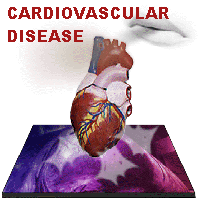
OVERVIEW

OVERVIEW
Cardiovascular disease (CVD) killed more people in this country last in 1987 (725,790) than any other disease. It actually starts in adolescence, predominately in boys. (Girls seem to be protected by female sex hormones.) After menopause, however, women and men have the same cardiovascular risk. Cardiovascular disease, as its name implies, is a disease that affects the heart and blood vessels. With age, blood vessels often become narrowed and more likely to have a surface which leads to the formation of a blood clot. A clot in the arteries that nourish the heart leads to a heart attack; a clot in vessels in the brain leads to a brain attack (often called a stroke). In each case, blood flow to the organ is interrupted, leading to lack of oxygen and subsequent death of cells (muscle cells in the heart and neurons in the brain). This overview will concentrate on coronary artery disease.
What causes CVD? Many theories have arisen to explain its occurrence. It is associated with high levels of "bad cholesterol" in the blood, carried in particles called low density liproprotein (LDL). It is also linked to low levels of "good cholesterol" in the blood, carried in particles called high density lipoprotein (HDL). High levels of other circulating species, such as homocysteine or a variant of LDL, Lp(a), also are associated with CVD. Other risk factors such as smoking and high blood pressure also add significantly to the risk. Although all these things are correlated with CVD, we are still learning about the mechanisms by which they promote the disease. Recently another causative agent has been associated with the development of CVD: infection by certain bacteria and/or viruses. The immune system is also implicated as well in the pathogenesis of the disease. Clearly, CVD, a chronic disease, is extremely complicated
NORMAL CORONARY BLOOD VESSEL STRUCTURE/FUNCTION:
The walls of a normal vessel consist of a layer of endothelial cells, which present a smooth, non-clotting surface to the blood components (cells - including red blood cells, white blood cells - lymphocytes, monocytes, eosinopils, basophils, platelets, - and plasma containing circulatory proteins (including albumin, antibodies, hormones, cytokines), small metabolites and various ions). Underneath the endothelial cells are smooth muscle cells which allow for constriction and relaxation of the blood vessel. Cardiovascular disease starts with a build-up first of fatty material underneath the endothelial cells. This is followed by recruitment of immune cells (like monocytes) into the sub-endothelium, where monocytes (which become stationary macrophages) take-up large amounts of LDL, becoming foam cells laden with cholesterol. At the same time, the monocytes send out proteins into the circulation which lead to the recruitment of more immune cells into this space. These immune cells release other proteins which lead to proliferation of smooth muscle cells under the endothelial layer. This build-up of immune-cells, foam cells, and smooth muscle cells leads to an the development of "plaque" underneath the endothelial layer, which changes the characteristics of the blood vessel. It becomes more rigid and less resillient (i.e. hardening of the arteries). With time, the fibrous plaque build-up to the point that it starts to occlude the blood vessel lumen (opening) causing narrowing of the arteries in the heart. Eventually this plaque can literally burst, which presents to the vessels a surface which strongly promotes clotting. A clot forming in the vessel then occludes the artery, restricting blood flow to regions of the heart, causing part of the heart cells to die. This is a heart attack or myocardial infarction.